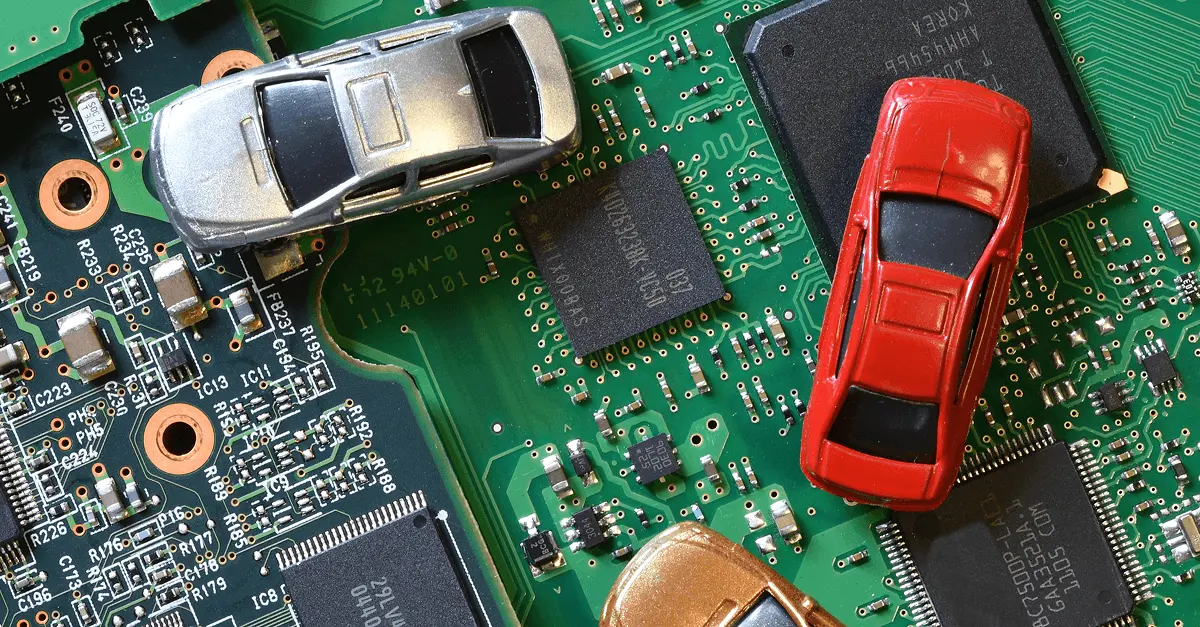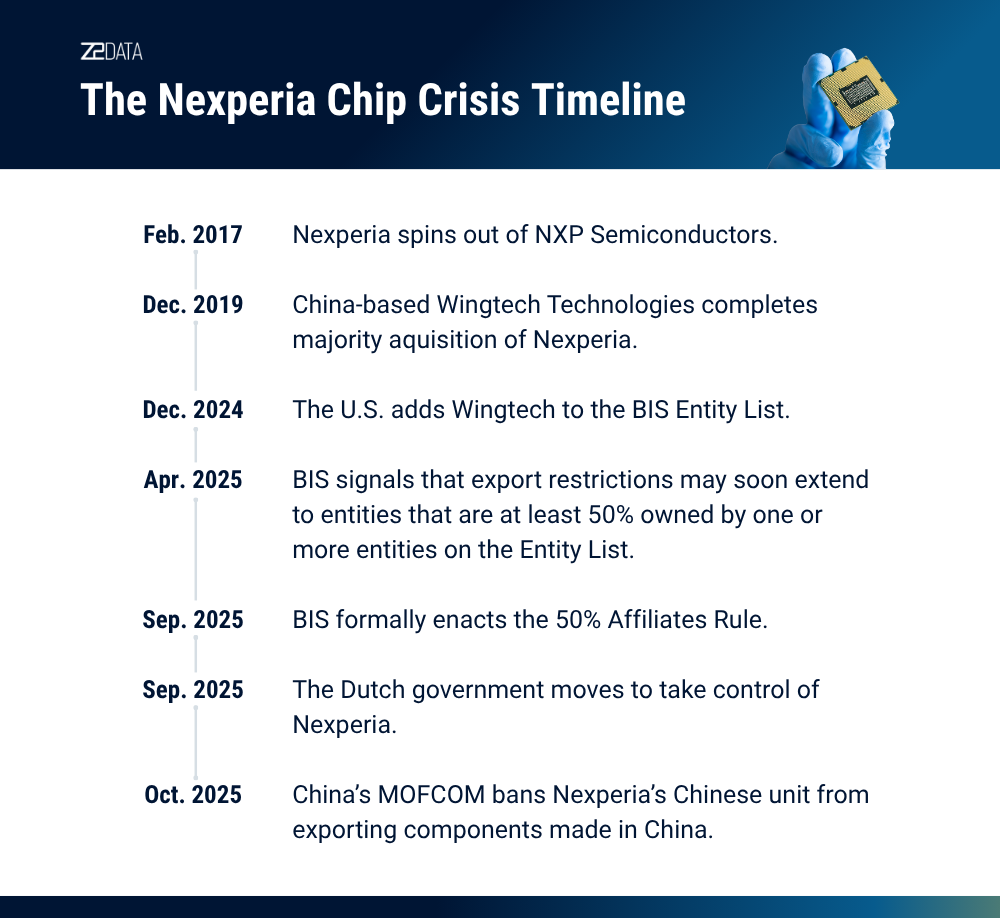The Nexperia Chip Crisis, Explained
Nexperia’s addition to the BIS Entity List and China’s export controls have sparked a global supply chain crisis. Automakers face looming chip shortages as the Dutch and Chinese governments clash over control.

What We Know Right Now
It all happened so fast. In the span of a few weeks, Nexperia went from a modestly sized semiconductor manufacturer based in the Netherlands to a business embroiled in an international conflict rife with political and technological intrigue. On September 29, the U.S. Department of Commerce issued a new rule that expands the scope of the Bureau of Industry and Security’s Entity List. The Agency’s new rule, as outlined on the BIS website, stipulates that any company that is “at least 50 percent owned by one or more entities on the Entity List or the Military End-User (MEU) List will itself automatically be subject to Entity List/MEU List restrictions.”

Nexperia was acquired by Chinese firm Wingtech Technology in 2019, and the technology company was placed on the BIS Entity List in December 2024. Therefore, based on the BIS’s new “Affiliates Rule,” as of September 29 Nexperia itself fell into the scope of the Entity List, becoming subject to the same export controls as its Chinese parent company. Just a day later, on September 30, the Dutch government scrambled to take control of Nexperia by invoking an obscure, Cold War-era law known as the Goods Availability Act. According to the Dutch government, this measure was carried out “following recent and acute signals” that “posed a threat to the continuity and safeguarding on Dutch and European soil of crucial technological knowledge and capabilities.” Some reporting has suggested that the Dutch government’s actions were a response to mounting pressure from the U.S. over the past few months. As of now, the Netherlands has denied these claims.
Less than a week later, on October 4, the Chinese Ministry of Commerce issued its own export controls. MOFCOM prohibited Nexperia’s Chinese unit and its subcontractors from exporting finished components and sub-assemblies manufactured in China to foreign countries. About two weeks later, Nexperia’s Chinese management instructed its staff to ignore orders coming from the company’s Dutch headquarters in Nijmegen, Netherlands. A letter written by the company’s Chinese management and obtained by the media on October 19 asserted that Nexperia is a “Chinese company with operations rooted in China” and therefore has a priority to adhere to Chinese regulations. The letter further implored employees to “disregard external interference,” a clear reference to the Dutch government’s attempts to seize control of Nexperia.
Following the directive from Nexperia’s Chinese management, the Dutch economy minister and his Chinese counterpart initiated efforts to reach some kind of resolution that would satisfy both sides and allow Nexperia to continue supplying chips to foreign customers. As of October 22, however, no such resolution had been reached. In the wake of these conversations, Chinese Commerce Minister Wang Wentao released a statement positioning the blame on the Netherlands for the impending supply chain fallout. “Measures taken by the Dutch side regarding Nexperia Semiconductor have seriously affected the stability of global industrial and supply chains,” he said. “China urges the Dutch side to proceed from the overall perspective of maintaining the security and stability of global industry and supply chains.”
Nexperia is currently working with Chinese authorities to secure an exemption and is engaged in discussions with both national and local government bodies to address the existing Chinese export restrictions.
Nexperia’s Role in the Automotive Supply Chain
Nexperia punches above its weight in terms of the number of chips it supplies to the global auto industry. With revenue of around $2 billion in 2024, the chipmaker sells roughly 60% of its products to auto manufacturers like Volkswagen, Toyota, BMW, and Mercedes-Benz. The company doesn’t manufacture the most cutting-edge chips for its automotive customers. It does, however, play a disproportionately large role in supplying basic chips like transistors and diodes, over which it controls a 40% market share.
As the European Automobile Manufacturers Association (ACEA) recently explained in a statement, Nexperia is a high-volume supplier of fundamental chips essential to the electronic control units used in vehicle electrical systems. “Without these chips, European automotive suppliers cannot build the parts and components needed to supply vehicle manufacturers,” the trade group said.
Supply Chain Consequences
As most of Nexperia’s semiconductors are manufactured in China, the Chinese Ministry of Commerce’s export restrictions pose the greatest threat to global supply chains. Several automakers are already sounding the alarm about an impending chip shortage and subsequent production stoppages.
On Wednesday, October 22, Volkswagen told its workers that a production stoppage could be imminent due to the supply chain issues triggered by the Nexperia crisis. Germany newspaper The Bild went so far as to cite sources saying that work stoppages were already being scheduled to start the following Wednesday, October 29. “In view of the dynamic situation,” a Volkswagen spokesperson told Reuters, “we cannot rule out an impact on production in the short term.”
A day later, on Thursday, October 23, the Japanese Automobile Manufacturers Association (JAMA) said that Nexperia had recently notified Japanese autopart manufacturers that it may not be able to guarantee chip deliveries. JAMA said that the semiconductors in question are essential components in electronic control units, and any shortages could reverberate across JAMA’s members, which include Toyota, Honda, and Nissan.
Automotive trade groups are aggressively voicing their concerns about this escalating crisis. “If the shipment of automotive chips doesn’t resume – quickly – it’s going to disrupt auto production in the U.S. and many other countries and have a spillover effect in other industries,” John Bozzella, CEO of the Alliance for Automotive Innovation (AAI), recently said in a statement. “It’s that significant. We’re urging a quick resolution, so U.S. and global automaking remains on track.”
The AAI’s European counterpart, the European Automobile Manufacturers Association (ACEA), characterized the situation in similarly dire terms. The organization recently said that it could take months for European automakers to find alternative suppliers for the chips they source from Nexperia. The auto manufacturers’ current supply, meanwhile, is only expected to last for another few weeks. “We suddenly find ourselves in this alarming situation,” ACEA Director General Sigrid de Vries said in a recent statement. “We really need quick and pragmatic solutions from all countries involved.”
Z2Data’s Recommendations
To mitigate this risk, Z2Data recommends immediately securing Nexperia inventory and qualifying alternate parts, with the highest priority given to Nexperia components manufactured in China.
By utilizing our Part Risk Manager tool, you can identify available inventory across all distributors, while our Cross Engine can specifically search for alternatives to Nexperia parts. In addition, our Supply Chain Watch tool can help companies pinpoint the Nexperia components they source that are being manufactured in China. To learn more about Z2Data and how the SCRM platform can help you effectively mitigate this looming supply chain risk, schedule a demo with one of our product experts. You can also contact your Z2Data representative or email info@z2data.com.
The Z2Data Solution
Z2Data’s integrated platform is a holistic data-driven supply chain risk management solution, bringing data intelligence for your engineering, sourcing, supply chain and compliance management, ESG strategist, and business leadership. Enabling intelligent business decisions so you can make rapid strategic decisions to manage and mitigate supply chain risk in a volatile global marketplace and build resiliency and sustainability into your operational DNA.
Our proprietary technology augmented with human and artificial Intelligence (Ai) fuels essential data, impactful analytics, and market insight in a flexible platform with built-in collaboration tools that integrates into your workflow.


.svg)






